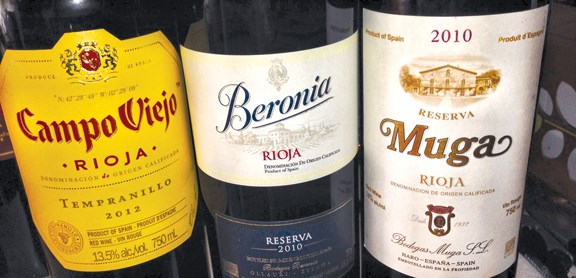Almost lost in the shuffle of this month’s pricing changes is a promo of Rioja wines at B.C. liquor stores.
Of all Spain’s tablewine regions, Rioja is arguably the most well-known and established. Over the last couple of years, the region’s popularity has been increasing, enjoying growing exports as well as growth, even in white wines. And, despite the economic hardships currently endured by so many Spaniards, Rioja continues to be popular across the board at home, which is more proof of its good value and as an excellent match for so many Spanish foods.
Rioja production (usually mainly Tempranillo but often blended with Garnacha and Graciano and Garnacha) is strictly controlled, and divided into four distinct categories for reds as follows: Joven or young wines, which tend to be fresh, fruity and quaffable; Crianza: wines in their third year that have spent at least one year in oak; Reserva: wines from the best vintages, aged for a minimum of three years, with at least one year in oak; and Gran Reserva: exceptional vintages, which have spent at least two years in oak casks and three years in bottles.
In a nutshell, with a little understanding and some sleuthing it’s often not hard to come up with some pretty good values.
As for food pairings, one of my favourite dishes since I returned from Spain last year is a simple fish soup, which you can whip up pretty quickly with some fresh shellfish, a little whitefish (or even salmon) and some seafood broth (buy halibut if you can find it), or even a mild chicken broth, if that’s more convenient.
Several of these medium-bodied Rioja reds make for excellent matches. And if all else fails, you can always try them with a good piece of cheese, such as Manchego.
“The Rioja Experience” features a dozen Rioja reds, with a rosé thrown in for good measure, in a range of styles and prices.
Here are some worth noting:
Rioja Antano 2012 (Crianza)
Here’s one of those budget Spanish wines where you really can’t go wrong for the money. A blend of Tempranillo, Garnacha and other grapes yields up-front red and black fruit, easy tannins and a decent finish. For $11.29 (before taxes) it’s a deal (88 points).
Campo Viejo 2012
Perennial good value, bright, ripe red fruits, medium-bodied with some spice and vanilla hints before a rounded finish (89 points, $14.79).
Beronia Rioja 2010 (Reserva)
Forward spicy, blue fruit and earthy notes followed by a juicy plate with refreshing acidity, black cherry and anise; plush and well structured, wrapped in firm but approachable tannins before a spicy, lingering end ($21.79, 91 points).
Muga Rioja (Reserva) 2010
Up-front spicy red fruit, raspberry and cherry notes, followed by mouth-watering acidity, an earthy, meaty palate, with distinct mineral notes, grippy tannins and a spicy, lingering finish. Think serious grilled red meats, such as lamb ($26.09, 91 points).
Marques de Cáceres Rioja Rosado 2013
Dry-ish but still fruity rosé makes for the perfect picnic wine, with strawberry and raspberry notes in a quite full body that can go with a variety of tastes including cold cuts and grilled chicken or just plain sippin’ (89 points, $14.79).
Tim Pawsey writes about wine for numerous publications and online as the Hired Belly at hiredbelly.com. Contact: [email protected].



